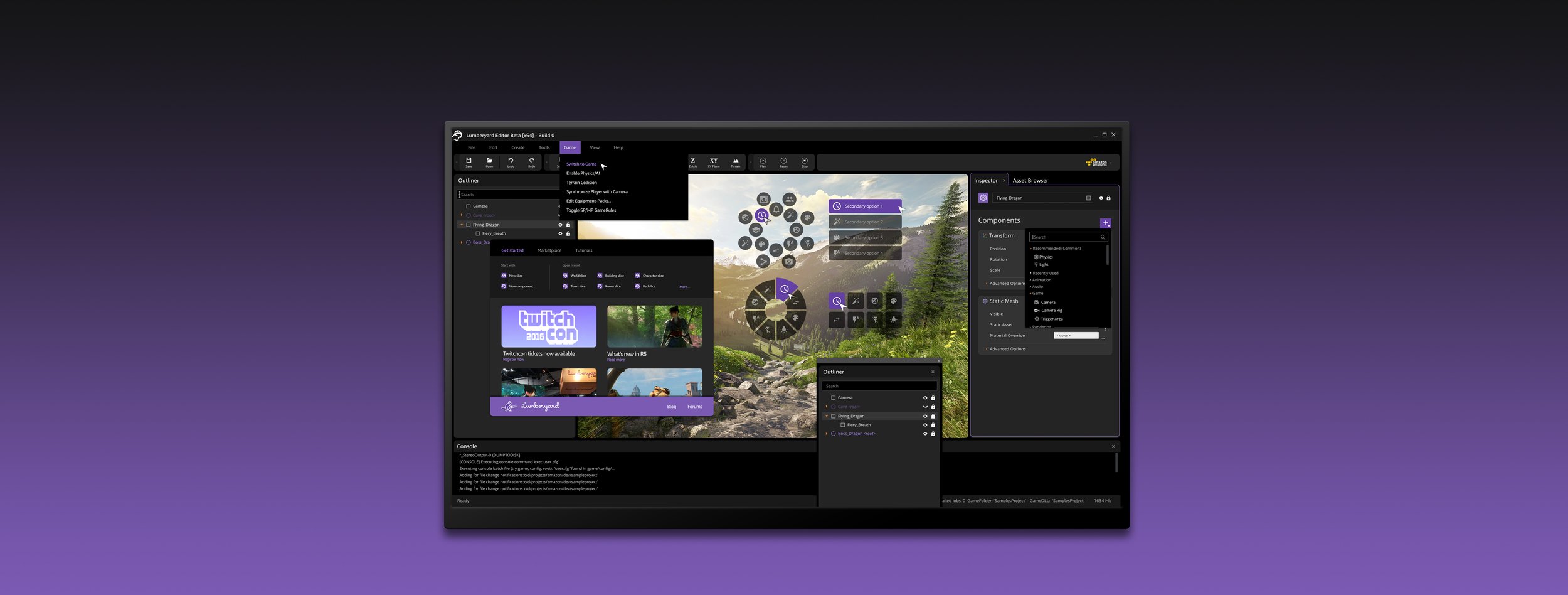
Amazon Lumberyard
CASE STUDY
AAA Game Developer Tools
Amazon Lumberyard (now O3DE) is a game engine originally developed to build Amazon’s 1st party AAA games. I was recruited to manage a team of designers responsible for improving existing and developing new user experiences across the entire Lumberyard suite of desktop applications (i.e., world building, physics, animation, environment, lighting, UI, etc.).
MY ROLE
Sr. UX Manager (hands-on)
TOOLS
Sketch, UserTesting.com, Photoshop, Qualtrics, Jira, Confluence
YEARS
2016-19
The Problem
Amazon purchased a branch of the CryEngine source code to kickstart the Lumberyard game engine. At the time, CryEngine was a powerful game engine, but it was extremely cumbersome to use by content creators as it had been cobbled together by various engineering teams over the course of a decade.
In short, if you were not already an expert at developing games with CryEngine, using Lumberyard was going to be extremely difficult.
The Customer
Game Developers: Lumberyard had one overarching customer in Game Developers, but we sub-divided that into three creator types that would interact with the engine differently…Content Creators, Design Technologists, and Coders.
Results and Learnings
Hundreds of Product Improvements
We successfully launched hundreds of product improvements that resulted in significant increases in System Usability Scores (SUS), Task Completion Times (TCT), and Net Promoter Scores (NPS).
New UI System
To be able to build an intuitive and cohesive experience across the dozens of tools inside of Lumberyard, we needed to develop a comprehensive UI system that would scale to solve for hundreds of individual and overlapping use cases.
Intuition Isn’t Enough
Lumberyard initially suffered from what I call, “this is how I’d do it” syndrome before we began applying a user-centered design process. The team often tried to solve problems based on our own experiences as game developers rather than spending time listening to what our actual customers wanted and needed.
How We Did It
UX Principles & Vision
Understanding ourselves is as important as understanding our customers. To that end, we ran several group exercises that enabled the design team to tease out and succinctly articulate what we were driving towards and why. We made posters of these and hung them in strategic locations in each office as a way of never losing sight of our underlying principles and vision.
Personas
When I joined Lumberyard the design team was set up in an agency model where each designer worked on various projects as needed. I restructured the team into a centralized & embedded model allowing each designer the time to become an expert in their focus area, leading to more trust from their engineering partners and a better understanding the customers they were designing for.
Design Sprints
I partnered closely with leaders on both the engine and game teams (i.e., New World and Breakaway) to understand existing application and workflow issues as well as issues stemming from the existing dynamic between the design and engineering teams. This led to the implementation of UX best practices, including design sprints. Several of these sprints ultimately resulted in a blue-sky prototype that reimagined the entire engine UX.
Iterations and Testing
Game engines are massive applications. Imagine grouping all of the apps in the Adobe Creative Suite into one workspace…that’s what a game engine is like…world building tools, terrain tools, scripting tools, lighting tools, animation tools, physics tools, and on and on. Each with a different content creation user, but all having to ultimately work together. The Lumberyard engine was a derivative of a pre-existing engine that had been cobbled together by disparate teams over the course of a decade. It was our job to redesign it all in a way that made sense to our end users.
New UI System
To be able to build an intuitive and cohesive experience across the dozens of tools inside of Lumberyard, we needed to develop a comprehensive UI system that would scale to solve for hundreds of individual and overlapping use cases.
End-to-End Prototype
Design sprints and customer interviews resulted in a comprehensive, high-fidelity prototype that illustrated a complete redesign of the Lumberyard suite of applications, starting with a new installation set up all the way through the various sub-applications needed to create and test a baseline game. It showcased how user-requested changes could reduce creator time down from days to 30 minutes or less, and became a product, engineering, and design alignment tool and a guiding light for future work.

